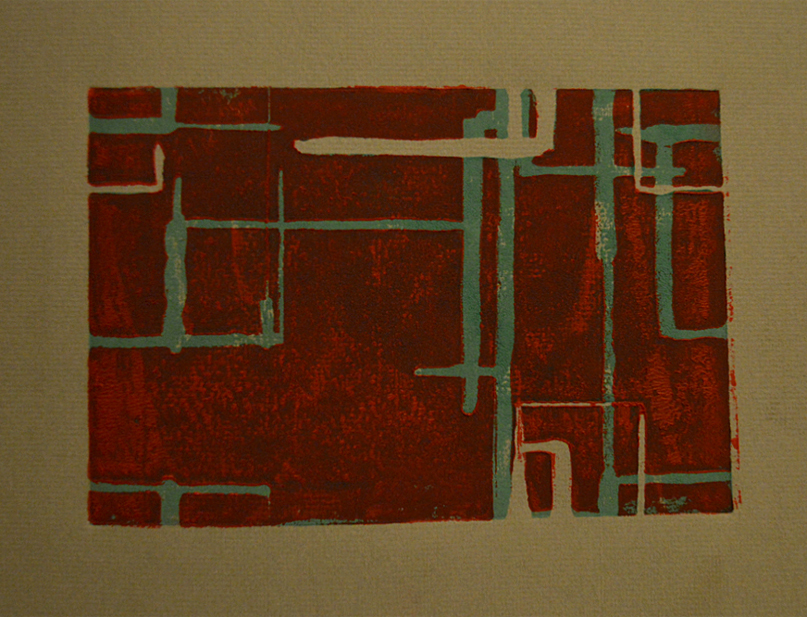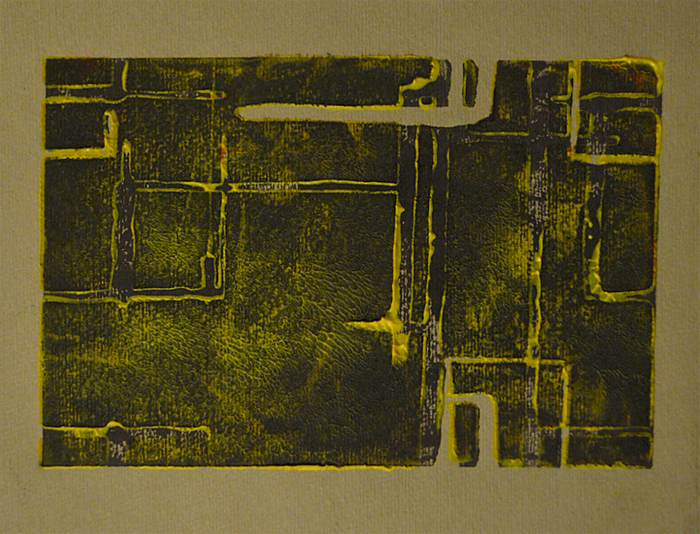No Drawing Thinking Lots
I set out tonight at around 9pm to do a 1 hour drawing and here I am drawingless. But I have not been idle. Nope. Not me. I've been giving myself a headache, recalling an insomnia inspired idea and trying to make it possible, if not very easy. The image for the post is an image of my generative linocuts, which are to feature in another post.
If you should know anything about me at all it's that I love the concept of translation. How information can be conveyed in different languages for example, and more importantly what is lost in that translation. Last night my brain decided to talk to me all about this until half past stupid o' clock in the morning. Out of that monologue came the idea of using a room as a data set to create an algorithmical painting from. The data is all of the information that the room contains and it is translated by an algorithm of my design into the abstract language of painting. I have specified 'abstract' as a term as I'm dealing with pure painting elements. Not all of them yet I admit, however some of the elements arise as emergent properties, but that's a different bunch letters and syntax altogether.
I've also begun bashing out an idea for an installation that might be good for a proposal if I find it suits.
Below I've put my algorithm down in writing as it seems to best work in my head. The language becomes more abbreviated and code like as the writing progresses. So without any further preambulation here is the pseudo 'code'. The algorithm will probably change during execution as I'll no doubt run into odd things I have not accounted for. I'll update when I try it.
ROOM GENERATED ART V1.0 (algorithm draft)
Variables
distance
direction
thickness
colour
tone
opacity
distance = max width/height of canvas
direction up to 360- easier with limits could be 4 -8
thickness as a % of voulme?
Finding the values
Distance= as a %of total (either width/height ) of canvas- from last object// distance from last object / width or height of canvas. (for simplicity sake use a square canvas.)
Direction = Height is up and down on a 50% basis or current object width/height ratio roll of %die Width is Left or Right 50/50 or as above
Thickness of line ( for simplicity work with 3 values THIN , MED, WIDE) (current object width * height/100 )*depth 0 -33=thin/ 34 – 67 =med/ 68-100 = wide.
Tone = compare last tonal value if current object is lighter then line is light else line darker.
Opacity- use clock face- 7-12 thicker1-6 thinner/ use what I would consider the front of the object how is it position relative to last object// gives six values of translucency vs opacity.
Colour range is found by first three objects closest to DOOR count duplicates of them in room /8 round to whole number. Can give mono/x2 or x 3 pallet
RULES and REFINEMEMT
Start from DOOR. Find start point on canvas = calculate ROOM orientation vs North. Calculate DOOR vs North. North =Up, EAST =Right, SOUTH =Down, WEST = Left.
Use DOOR orientation vs North as start side.
Calculate width as % of perimeter = W%. If right hand wall is closer to East then startg line begins W% from Right of canvas else from Left.
Calculate height as % of perimeter = H%. If left hand wall is closer to North then line begins H% from top else from bottom.
Finding pallet(colour) – either use reduce ROOM pallet to 3 main colours or use 8 hue spectrum as % (12.5% per hue) If room is:
- higher than wide or deep = x1 colour volume of room (ROOMVOL) / D *100 Hue1.
- wider than high or deep = x2 colours = Hue1; ROOMVOL / H 100 = hue1;
- deeper than high or wide =x 3 colours = Hue1; Hue2; ROOMVOL/ W * 100 =Hue3
If room orientation = more North than South work CW round ROOM, else CCW.
Lines
Line Distance (Ldis)
Calculate distance to First Object (FO) from DOOR. Find as % of ROOM= DIS%. This is the % the line will move on canvas or CAN%. DIS% = CAN%
FO tonal value = neutral (Neut).
Measure the FO for Height (H), Width (W), Depth(D)- Note orientation vs North = Original Orientation (OO)
Line Direction (Ldir) =
- If Object (O) is taller than wide, direction is Up/Down (U/D). Else Left/Right. (L/R)
- If U/D – calculate the H/W ratio of Current Object (CO) use ratio as % value for U vs D
- If L/R do as above but W/H.
- If H=W then line is UL/UR/DL/DR. If object(O) is closer to :
- North Wall it is UL
- South Wall it is UR
- West Wall it is DL
- East Wall it is DR
Line Thickness (Lthk)
Current Object (CO) (H*W)/100)*D = Lthk%
if Lthk% < 33 then Lthk = thin
else if Lthk% < 67 then Lthk = med
else Lthk >68 then Lthk = Wide.
Move to next closest object :
- CO front vs OO = opacity re opaticy rules.
- Tone = CO tone value vs Neutral. Re tone rules
- cal Ldis ; cal Ldir. Draw line.
- REPEAT until all objects used.
If object touches another object END current line.
Restart New Line Layer re DOOR, where CO = DOOR. Recalibrate Opacity and tone.
If object has small objects on top.
Cal Ldis as % of CO surface; cal Ldir % of CO surface. Do for each objects moving current CCW or CW direction around surface. Draw line as thin only branching from middle of current line. When all surface objects used begin original cals from current line end.
In sickness and wasps
I've not been here as often, as I would like recently, but here's what's new. My kids have been ill which has really sucked. I know looking after one ill child is tiring, but two feck me. I seemed to spend all of my energy on them and have none left over for art making.
I eventually got back in my cave of paint yesterday. My enthusiasm was quickly squashed by a swarm of wasps, that launched an attack on me mid painting. Well... when I say swarm and attacked, I mean one, solitary winter drowsy wasp, who so happened to take a rest on my jumper. I responded by bravely panicking and yelling words that would make a sailor cry. I courageously removed my jumper, encasing the wasp within and placed the jumper securely in a bin bag. The bin bag was placed within a bin and later removed and safely squashed by the binmen. Hooray!
Further investigation of the cave of paint has revealed a burgeoning wasps nest which is to be dealt with.
I had started this before I was rudely interrupted. I have dedicated my study of Sheffield city to that ill fated wasp. It is destined to be a study for a larger more abstract piece based on Sheffield city.
Dodging the swarm, Oil on Oil painting paper, 10" x 7" - Sheffield city study for a larger piece.
I hope your day remains waspless and warm.
Print-a-geddon
Well hello again. It's another post from me. The week has been a busy one, both art wise and life wise ( I say life and mean housework. I don't want to bore you with the details so I won't.) My main news is I have begun a series of test linocuts. The response to which has been more than favorable.
Below is my print station. I would work in the cave but that means cleaning up my oil painting messes.....so the table wins.
I was hoping to get more of the printing finished, but thats not how it worked out. So I'll be getting that sorted this week. I have a few pieces of lino to use, and experiment with. I'll try some portrait, landscape and more dice work. Oh I should say the prints below are based on a simple algorithm I devised. I'll just run off and get the fun spreadsheet. BRB!
The spreadsheet gives the DIRection of the line, the DIStance of the line and which linocutter should be used to cut the line. The numbers beside the DIR and DIS are dice that are to be used to calculate variable. STG means Stage, LYR means Layer. That probably doesn't help at all. Spreadsheets are fun!!
Below is a gallery of prints made by the algorithm (they are all the same linocut, but with different inks)
In other news I made more paintings and kittens are still cute! I'll post the paintings tomorrow.
No pithy and witty title
An odd day in the cave. I got a good day of painting in, I didn't have any 'painters block' nor were there any interruptions. Yet I still feel underwhlemed. The only reason I can think of is that I spent all day on one painting -'Procedural Painting V3.1.2 20"x 20" Oil on board.'
I'm using emergent properties in this one, so when lines cross from different layers they create a random number of rectangles or circles each with their own set of random elements, such as size, line thickness and opacity of paint to name a few. All of these variables must be roll fro on the hoof, as I have no idea when lines will cross. That creates a huge amount of dice rolling - in total I spent over an hour rolling dice.
Below I have a picture of layer 4 finished but without the emergent properties, followed by an image with the properties put in.
On the left is Layer 4 before I add in the emergent properties and on the right after they have been added. Each aspect of the emergent properties must be calculated, its position relative to it's origin point, it's form, style, thickness of paint and line and the tonal values I could go on and on.
No real conclusion to this post except for this little thing near the bottom of the 'e' at the end of here.
Stuff and Guff
Soundcloud is where I put my sonic dreams. When I make them.























